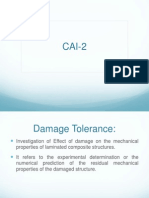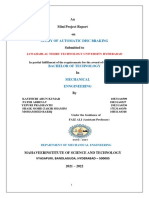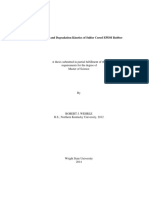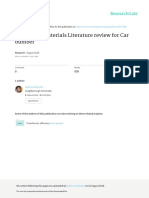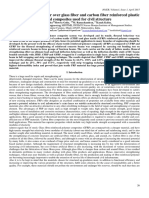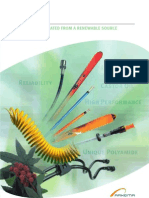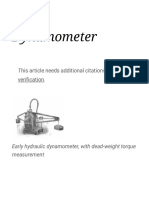C GR Tire Rolling Resistance
C GR Tire Rolling Resistance
Uploaded by
sniper1720Copyright:
Available Formats
C GR Tire Rolling Resistance
C GR Tire Rolling Resistance
Uploaded by
sniper1720Original Title
Copyright
Available Formats
Share this document
Did you find this document useful?
Is this content inappropriate?
Copyright:
Available Formats
C GR Tire Rolling Resistance
C GR Tire Rolling Resistance
Uploaded by
sniper1720Copyright:
Available Formats
R E P O R T
MARCH 2003
LOW ROLLING RESISTANCE TIRES
80% or more of a cars fuel energy is wasted by friction and other such losses 1.5 to 4.5% of total gasoline use could be saved if all replacement tires in use had low rolling resistance About 237 million replacement tires are sold in the U.S. each year none has rolling resistance labeling This report presents previously unpublished data on leading tires with low rolling resistance
Americas Fuel Use, Its Impacts, and Opportunities for Savings
he environmental impacts of Americas gasoline use are profound. With over 160 million passenger cars and light trucks on the road, we burn about 126 billion gallons of gasoline per year. Our fuel use continues to rise about 3% annually, propelled by continued increases in total number of vehicles, rising average distance driven per car, and falling average fuel economy. Today, light-duty vehicles (cars & light trucks) are responsible for about 20% of the nitrogen oxides, 27% of the volatile organic compounds, 51% of the carbon monoxide, and roughly 30% of all the carbon dioxide (the main greenhouse gas) emitted from human activities nationwide. Rising fuel use also has enormous implications for protection of wilderness and public lands (vulnerable to increased exploration), water resources (vulnerable to tanker and pipeline accidents), and national security. So the opportunity to save money and improve environmental quality through fuel use reductions is clear. One of the most promising opportunities for fuel savings
S E A L S
G R E E N
across the entire fleet of existing vehicles is to utilize low rolling resistance tires instead of standard replacement models. This change improves the inherent efficiency of the vehicle, automatically saving fuel over the typical 30,000 to 50,000 mile lifetime of a set of tires. This report examines the opportunity for saving gasoline through use of improved tire technology and recommends particular tire models for which our initial test data suggest environmental advantages. Its findings are applicable to government and corporate fleet managers as well as individual tire buyers.
How Tires Can Reduce Fuel Consumption
According to the National Academy of Sciences, about 80 to 88% of the energy in a vehicles gasoline tank is wasted in various thermal, frictional, and standby losses in the engine and exhaust system. This leaves only about 12 to 20% of the potential energy actually converted to vehicle motion. One of the key ways to improve that efficiency is to reduce the rolling resistance of vehicle tires. This is not a measure of a tires traction or grip on the road surface, but rather simply indicates how easily a tire rolls down the road, minimizing the energy wasted as heat between the tire and the road, within the tire sidewall itself, and between the tire and the rim. Detailed modeling conducted by the National Renewable Energy Laboratory concluded that a 10% reduction in tire rolling resistance should yield fuel savings of about 1 to 2%, depending on driving conditions and vehicle type. According to research for the California Energy Commission, about 1.5 to 4.5% of total gasoline use could be saved if all replacement tires in use had low rolling
The Choose Green Report is published for Green Seal Environmental Partners. To become an Environmental Partner, or to receive a copy of this report, contact Green Seal at 202-872-6400 or greenseal@ greenseal.org. Green Seal President and CEO, Arthur B. Weissman Researchers, My Ton, Chris Calwell, and Travis Reeder, Ecos Consulting Design, Cutting Edge Design Support provided by the Energy Foundation Printed on Green Seal-certified Mohawk Satin Cool White Recycled paper, 30% postconsumer content Copyright 2003, Green Seal, Inc. www.greenseal.org
GREEN SEAL Environmental Partner
2 Choose Green Report
resistance. This translates roughly into average savings of up to 30 gallons of gasoline savings per vehicle per year, or from $2.5 to $7.5 billion worth of national average gasoline savings. As part of their efforts to meet Federal fuel economy standards, automakers routinely specify low rolling resistance tires on their new vehicles. Between 1980 and 1994, the lowest rolling resistance tire models available achieved a 48% reduction in rolling resistance, As part of their and have efforts to meet likely continFederal fuel ued to improve economy thereafter. standards, These original automakers equipment (OE) tire routinely models are specify low occasionally rolling available in the replaceresistance tires ment tire on their new market, but vehicles. often only by special order. In general, the tires marketed to the replacement tire market tend to place greater emphasis on longevity and low price, and therefore often have higher rolling resistance than OE tires. Unfortunately both OE and replacement tires lack any sort of rolling resistance labeling currently, so fleet managers and consumers that wish to buy highly energy-efficient tires when their first set of OE tires wear out have been stymied. Even when tire makers claim that particular replacement models are more fuelefficient than others, they do not always use consistent test methods or independent laboratory data to back up those claims. About 237 million replacement tires are sold in the U.S. each year for cars and light trucks, and none of them
provides rolling resistance labeling. In 2002, the Energy Foundation funded Ecos Consulting to analyze the tire market, select representative models for rolling resistance testing, and work with Green Seal to recommend particular models that perform well while achieving low rolling resistance. Those findings are being published for the first time in this Choose Green Report. Additional background on Ecos Consultings key findings can be found in a separate report prepared for the California Energy Commission, available at www.energy.ca.gov/reports/200301-31_600-03-001CRVOL2.PDF.
Balancing Tire Resistance and Other Considerations
The manufacture of tires, like other industrial processes, involves material extraction and production, as well as energy consumption and the emission of various pollutants. Each of these manufacturing stages impacts the environment in different ways. However, tires, like a number of other consumer products, are actually responsible for more environmental impacts in their use and ultimate disposition than in their manufacturing. They significantly impact the amount of fuel consumed by the vehicle to which they are attached, leading to global warming emissions as well as local and regional air pollution. They create particulate air pollution in the process of wearing, and they can be a significant solid waste problem if not properly recycled. An analysis conducted by Italian tire manufacturer Pirelli (Figure 1) revealed the dominance of tire use in overall life-cycle energy consumption. Fully 82% of the lifecycle energy use occurs from the tires contribution to vehicle fuel use, compared to roughly 18% associated with obtaining the raw materials and manufacturing the
FIGURE 1: DISTRIBUTION OF TIRE ENERGY CONSUMPTION
Collection at End-of-Life 0.056% Use (Tire Debris and Fuel) 82% Raw Materials 12.097% Compound Recycling 0.194% Tire Production 5.950%
Distribution 0.076%
Source: Pirelli SA
tire itself. Thus, a tires rolling resistance is likely to be a larger factor in its life-cycle environmental impact than its composition, longevity, or ultimate fate, though those factors merit consideration as well. This report places greatest significance on the measured rolling resistance of tires, followed closely by consideration of the tires expected longevity and performance characteristics. A tire with high rolling resistance can cause profound environmental impact, even if it capably grips the road and lasts for 80,000 miles. By contrast, a very low rolling resistance tire may not be worth recommending if its lifetime is unusually short or test data indicate that it provides poor traction. Every tire currently on the market represents a balance between a wide assortment of desired performance characteristics and price (we surveyed tires ranging from $25 to over $200 per tire). Careful balancing of these characteristics can yield not only a high-performing tire, but also one that is better for the environment than others currently available on the market.
Rating Tire Rolling Resistance and Related Factors
Rolling resistance has traditionally been measured through an official Society of Automotive Engineers (SAE) test procedure known as J1269. It measures the force required to roll a tire against a dynamometer at a fixed speed of 50 miles per hour. A newer procedure, SAE J2452, promises improved accuracy by assessing rolling resistance at a variety of speeds, but no independent laboratory currently has the capability to conduct such testing in-house. As a result, all of our testing was conducted at a single independent laboratory according to SAE J1269. The highest and lowest rolling resistance tires we tested differed in efficiency by 60%, indicating that tire choice can have a bigger impact on fuel economy than most people realize. Rolling resistance differences of 20 to 30% are not uncommon among tires of an otherwise similar size, type, and level of performance. This means an individual vehicle could save up to 6% of its gasoline use if it were
fitted with very efficient tires, paying for the modest additional cost of low rolling resistance tires in approximately a year of fuel savings. In other words, a typical compact car such as a Ford Focus can improve its mileage from 30 mpg to 32 mpg simply by using lower rolling resistance tires. For a car averaging 15,000 miles per year the fuel savings is about $50 (at $1.50 per gallon) All tires have imprinted information on their sidewalls indicating size, type, load, and speed ratings, as described in Figure 2. The majority of tire models employ a P designation for passenger vehicle use, but some bear the LT designation for use with light trucks. In general, P tires appear to be gaining in popularity relative to LT tires of a given size. In addition, the U.S. Department of Transportation requires each manufacturer to grade its tires under the Uniform Tire Quality Grading System (UTQGS) and establish ratings for the following characteristics: tread wear, traction, and temperature resistance. Unfortunately, the ultimate results published for each tire model are less uniform than they should be. The government specifies how each test should be conducted and prevents a manufacturer from claiming better performance than measured. However, it does not prevent manufacturers from claiming worse performance than measured. And, curiously enough, many do, primarily to amplify marketing distinctions among their tires at different price points and encourage buyers to move up from a good to a better or best model in a particular category. Given the variability of ratings and the number of relevant factors, we have compiled our own composite metrics of performance for assessing tires, including the Federal ratings noted below and a variety of other published data, as follows:
Choose Green Report
FIGURE 2: KEY INFORMATION FOUND ON TIRES
a minimum traction rating of A. Traction in a wide variety of other circumstances (cornering, dry conditions, snow, etc.) can also be very important, so we evaluated test data from Consumer Reports where available, which included considerations of the impact of antilock braking systems as well. We also evaluated Tire Rack.com customer survey data on traction in a variety of road conditions, averaging the data available for each model to produce a composite traction score.
I OVERALL CUSTOMER
Source: www.tireadvisor.com
I ROLLING RESISTANCE We
assessed rolling resistance for 51 different currently available tire models in four sizes. These models represent only a fraction of the hundreds of models currently available today, but were chosen because previous tests or manufacturing claims indicated they might have lower than average rolling resistance or other distinctive performance features (best wet traction, high overall satisfaction, etc.). The models we tested had rolling resistance coefficients ranging from 0.0062 to 0.0152 (see Figure 3). We recommend models with an RRC of 0.0105 or less, recognizing that low values are somewhat more difficult to achieve on larger, heavier tires than on smaller, lighter weight models.
I TREAD WEAR The UTQGS test
twice the longevity) of a tire that scored 100. Few tires score less than 100, while the most durable models are rated at 600, 700, or more. Scores of 350 or more indicate aboveaverage levels of durability, and we recommend a minimum rating of 300. We also evaluated two other measures of tire durability from several Internet sources (including Tire Rack.com), where available: our information represents customer survey responses reflecting over 2 billion miles of total driving, and assessments of manufacturer warranties that consider both the total mileage covered and the comprehensiveness of the warranties. We averaged all the data available for each model to produce a composite tread wear score.
I TRACTION The UTQGS mea-
SATISFACTION Tire Rack.com has asked its customers if they would buy various tire models again. The response received, on a scale of 1 to 10, reflects the best overall indicator of customer satisfaction with particular tire models, reflecting traction, handling, value, noise, and comfort. Note: We did not employ the UTQGS temperature resistance values (A, B, or C) when selecting tires for this report. While A rated tires are generally preferred, the linkages between high temperature resistance and greater longevity or lower rolling resistance are still somewhat controversial. Tread wear, traction, and customer satisfaction scores were averaged into an overall composite performance score. The average score for the 450 tire models in our database was 6.82. Such results are still imperfect, in part because Consumer Reports test data and TireRack.com data are not available for all models, leading to excessive reliance on the flawed UTQGS values for some tires.
assesses how much tread is lost from a particular tire after being driven a known distance on a government test course. A tire with a score of 200 would have half the wear (and roughly
sures straight-line tire wet braking traction and reports tire performance using qualitative grades of AA, A, B, or C, with AA being the highest. We recommend that you choose tires with
Green Seals tire recommendations represent tires with a greater than average performance score and a
Choose Green Report
rolling resistance coefficient of less than 0.0105. These
FIGURE 3: AVERAGE PERFORMANCE AND ROLLING RESISTANCE OF TESTED TIRE MODELS
185/70-14 Not Recommended 205/55-16 235/75-15 245/75-16 185/70-14 Recommended 205/55-16 235/75-15 245/75-16 Average Performance Score for All Tires in Database = 6.82
are listed individually in Table 0.016 1. Note that the tire sizes listed are the 0.014 individual sizes that we tested, but most 0.012 models are available in a wide 0.010 array of sizes. Because of the 0.008 difference in tire weights across the 0.006 various sizes, absolute RRCs are 0.004 more meaningful 3 within a particular size than across a range of sizes. However, a tire model that managed a relatively low rolling resistance within one size is likely to perform relatively well in a different size as well, all other things being equal. Also note that some of the recommended models are all season radials or performance-oriented models, while others are snow tires. Be sure to choose the model that best
Rolling Resistance Coefficient
RRC Cutoff = 0.0105
6 Performance Composite Score
suits your needs (websites like tireadvisor.com and tirerack.com can assist with that process).
Rolling On to the Future
Efforts to differentiate replacement tires on the basis of rolling resistance are still in their very early stages. Without data on the
rolling resistance of all tire models across a range of sizes, it is impossible to say for sure if the models identified in this report represent the most efficient models or simply a subset of them. For now, consumers and fleet managers can start with the data shown here and request additional information directly from retailers and manufacturers.
TABLE 1: RECOMMENDED TIRE MODELS
BRAND MODEL SIZE RRC AVERAGE PRICE TRACTION COMPOSITE WOULD BUY AGAIN COMPOSITE TREAD WEAR COMPOSITE PERFORMANCE SCORE
Bridgestone Nokian Sumitomo Dunlop Dunlop Bridgestone Goodyear Continental Michelin Michelin Dunlop Michelin Dunlop BF Goodrich Michelin Michelin Bridgestone
B381 NRT2 HTR 200 Graspic DS-1 SP40 A/S Blizzak WS-50 VIVA 2 ContiTouring Contact CH95 Pilot Alpine EnergyMXV4 Plus SP Winter Sport M2 Arctic AlpineXL Axiom Plus WS Long Trail T/A XPS Rib LTX M/S Dueler A/T D693
185/70R14 185/70R14 185/70R14 185/70R14 185/70R14 185/70R14 185/70R14 205/55R16 205/55R16 205/55R16 205/55R16 235/75R15 235/75R15 245/75R16 LT245/75R16 245/75R16 245/75R16
0.0062 0.0085 0.0092 0.0092 0.0103 0.0103 0.0104 0.0083 0.0090 0.0090 0.0102 0.0081 0.0088 0.0092 0.0101 0.0103 0.0103
$62.00 $67.00 $36.00 $46.00 $41.00 $68.00 $47.96 $64.00 $125.00 $118.00 $98.00 $79.00 $43.00 $76.00 $167.90 $139.00 $104.00
8.00 8.00 8.15 7.50 8.00 7.91 7.00 7.46 7.56 7.64 8.55 8.10 8.00 7.94 6.70 7.97 8.00
8.30 7.90 8.70 6.10 8.60 6.00 8.50 6.20 8.10 8.30
5.96 5.72 7.05 6.60 7.18 6.04 6.52 7.29 8.00 6.87 7.80 7.10 5.88 7.11 8.00 7.37 7.20
6.98 6.86 7.83 7.33 7.59 7.55 6.80 6.95 8.05 6.84 8.17 7.90 6.94 7.08 7.60 7.88 7.60
NOTE: The lower the rolling resistance coefficent (RRC), the more efficient is the tire; all tires listed here meet Green Seals criterion for rolling resistance of less than 0.0105 and are among the most efficient available in the market today. In contrast, the higher the value of Traction Composite, Would Buy Again, Composite Treadwear, and Composite Performance Score, the better in those measures the tire is; however, all tires listed here have a greater than average performance score in these respects. 2003, Green Seal Inc. Use of this table for commercial purposes is prohibited.
Choose Green Report
1001 CONNECTICUT AVE., NW SUITE 827 WASHINGTON, D.C. 20036
NON-PROFIT ORG. US POSTAGE PAID WASHINGTON, DC PERMIT NO. 5515
IN THIS ISSUE
Tires Saving fuel with low rolling resistance tires Recommended tire models
WHAT IS GREEN SEAL?
Green Seal is a non-profit organization whose mission is to achieve significant environmental benefits by encouraging environmentally responsible products and purchasing. We accomplish this goal in several ways. We set rigorous environmental standards for products and services and award a seal of approval to manufacturers meeting the standards. When purchasers select products bearing the Green Seal, they know they are buying products that have a lessened impact on the environment, without sacrificing performance. Through our Green Seal Environmental Partners Program and the Choose Green Reports, we help large and small institutions become environmentally sensitive purchasers by providing detailed guidance, such as this report. Green Seal also works directly with institutions and government agencies to help them green their purchasing and operations. Please contact us to find out how you can become a partner and receive our reports or receive our purchasing assistance.
You might also like
- Compression After ImpactDocument22 pagesCompression After Impactviswanathyakkala100% (1)
- Potential of A Production DI Two-Stroke Engine Adapted For Range Extender and Motorcycle ApplicationsDocument24 pagesPotential of A Production DI Two-Stroke Engine Adapted For Range Extender and Motorcycle ApplicationsManuelLentiNo ratings yet
- Tyre Paper PDFDocument153 pagesTyre Paper PDFSuchismita SahooNo ratings yet
- Examination of ATV Tire Forces Generated On Clay, Grass and Sand SurfacesDocument14 pagesExamination of ATV Tire Forces Generated On Clay, Grass and Sand SurfacesBreno VieiraNo ratings yet
- A Review Paper - Development of Novel Friction Material For Vehicle Brake Pad Application To Minimize Environmental and Health IssuesDocument4 pagesA Review Paper - Development of Novel Friction Material For Vehicle Brake Pad Application To Minimize Environmental and Health IssuesgarvitNo ratings yet
- No. Sinonim / Nama Dagang Rumus Molekul Nama Bahan Kimia: Daftar Bahan Berbahaya Dan Beracun (B3) Yang DigunakanDocument7 pagesNo. Sinonim / Nama Dagang Rumus Molekul Nama Bahan Kimia: Daftar Bahan Berbahaya Dan Beracun (B3) Yang DigunakanDhani PriyambodoNo ratings yet
- Design and Analysis of Non-Pneumatic TyreDocument11 pagesDesign and Analysis of Non-Pneumatic TyreYahia Mustafa AlfazaziNo ratings yet
- Optimization of Welding Process ParameterDocument62 pagesOptimization of Welding Process ParameteraktekshareNo ratings yet
- A Pin-On-disc Tribometer Study of Disc Brake Contact Pairs With Respect ToDocument7 pagesA Pin-On-disc Tribometer Study of Disc Brake Contact Pairs With Respect ToNAVNEESH SONKARNo ratings yet
- An Mini Project Report On: Study of Automatic Disc BrakingDocument36 pagesAn Mini Project Report On: Study of Automatic Disc BrakingNaveen luckyNo ratings yet
- An Analytical Model For The Transient Rolling Resistance Behavior of Tires 2Document15 pagesAn Analytical Model For The Transient Rolling Resistance Behavior of Tires 2siritapeNo ratings yet
- Tribology International: Rongping Yun, Peter Filip, Yafei LuDocument10 pagesTribology International: Rongping Yun, Peter Filip, Yafei LuRajiv Gandhi Rajiv GandhiNo ratings yet
- History of TyresDocument16 pagesHistory of Tyresmaryam009khanNo ratings yet
- N330 Carbon Black Info SheetDocument2 pagesN330 Carbon Black Info SheetDare AdeoyeNo ratings yet
- Carbon Carbon Piston - NasaDocument16 pagesCarbon Carbon Piston - Nasakanta118No ratings yet
- Devulcanized RubberDocument37 pagesDevulcanized RubberAnshul Jain100% (1)
- Silica and Carbon BlackDocument14 pagesSilica and Carbon Black14021292No ratings yet
- MBD A320neo Brake Insert Nov 15 MidDocument1 pageMBD A320neo Brake Insert Nov 15 MidHaliunaa BatboldNo ratings yet
- Relationship Rolling Visco ElasticDocument13 pagesRelationship Rolling Visco ElasticsiritapeNo ratings yet
- Adhesive Presentation - TomblinDocument30 pagesAdhesive Presentation - Tomblinhelton_bsbNo ratings yet
- Airless TyresDocument20 pagesAirless TyresKingsly Jasper100% (1)
- Carbon Black For WeatherstripsDocument8 pagesCarbon Black For WeatherstripsLucianoNo ratings yet
- Ijas KN 2MB08AT005 8 Sem, B-Arch Msi A A: Sumbitted To Ar .Chahat SheikDocument8 pagesIjas KN 2MB08AT005 8 Sem, B-Arch Msi A A: Sumbitted To Ar .Chahat SheikAhmed MilasNo ratings yet
- The Curing and Degradation Kinetics of Sulfur Cured EPDM RubberDocument61 pagesThe Curing and Degradation Kinetics of Sulfur Cured EPDM RubberWilliamNo ratings yet
- N1021A Novotema Elastomer Chemical Compatibility Brochure enDocument31 pagesN1021A Novotema Elastomer Chemical Compatibility Brochure enИбрагим НурмамедовNo ratings yet
- Astm d413 1982Document7 pagesAstm d413 1982dharlanuctcomNo ratings yet
- Composite Materials Literature Review For Car Bumber: August 2016Document12 pagesComposite Materials Literature Review For Car Bumber: August 2016meita alviraNo ratings yet
- Introduction To Process OilsDocument17 pagesIntroduction To Process OilsAlmira FadhillahNo ratings yet
- Comparison of Jute Fiber Over Glass FibeDocument5 pagesComparison of Jute Fiber Over Glass FibeBobby LupangoNo ratings yet
- Aircraft Tire PropertiesDocument2 pagesAircraft Tire PropertiesPaul Orellana0% (1)
- SES - Plastics Testing & CharacterizationDocument8 pagesSES - Plastics Testing & CharacterizationSES_CincinnatiNo ratings yet
- Stress Analysis of Automotive Chassis With Various ThicknessesDocument6 pagesStress Analysis of Automotive Chassis With Various ThicknessesRtdpDinuNo ratings yet
- Salt Spray Testing - Why It Should Not Be Used To Compare Different Types of CoatingsDocument2 pagesSalt Spray Testing - Why It Should Not Be Used To Compare Different Types of Coatingsdwimukh360100% (1)
- Influence of Camber Angle On Tire Tread Behavior by An On-Board Strain-Based System For Intelligent TiresDocument9 pagesInfluence of Camber Angle On Tire Tread Behavior by An On-Board Strain-Based System For Intelligent TiresAmier AziziNo ratings yet
- Astm d413, Astm f904, Astm d7005 DiffrentialDocument2 pagesAstm d413, Astm f904, Astm d7005 DiffrentialAnonymous TYGiADNo ratings yet
- Rubber Type: Teknologi KaretDocument13 pagesRubber Type: Teknologi KaretlarasatiNo ratings yet
- General Tyre ReportDocument23 pagesGeneral Tyre ReportAliHarmanAnsariNo ratings yet
- An Overview of Mechanical Properties and Durability of Glass-Fibre Reinforced Recycled Mixed Plastic Waste CompositesDocument15 pagesAn Overview of Mechanical Properties and Durability of Glass-Fibre Reinforced Recycled Mixed Plastic Waste CompositesYara MounaNo ratings yet
- Apollo Prediction of Tread Geometry Influence On Ply Steer Residual Aligning Torque (PRAT)Document9 pagesApollo Prediction of Tread Geometry Influence On Ply Steer Residual Aligning Torque (PRAT)Patrick DavisNo ratings yet
- Course: B.Tech Mechanical Subject: Elements of Mechanical Engineering Unit-1Document84 pagesCourse: B.Tech Mechanical Subject: Elements of Mechanical Engineering Unit-1Amogh VaishnavNo ratings yet
- RMA MO 1 2015 Classes and Tolerances For Molded Rubber ProductDocument15 pagesRMA MO 1 2015 Classes and Tolerances For Molded Rubber ProductOmeNo ratings yet
- Crash Test Regulations v1Document48 pagesCrash Test Regulations v1oupoupoupNo ratings yet
- Rubber, 5. Solution Rubbers: 1. Synthesis by Anionic PolymerizationDocument32 pagesRubber, 5. Solution Rubbers: 1. Synthesis by Anionic PolymerizationJohn Patrick DagleNo ratings yet
- Carbon Black: Professor Joe Greene Csu, ChicoDocument13 pagesCarbon Black: Professor Joe Greene Csu, Chicoviluk100% (1)
- CRP 02 01Document18 pagesCRP 02 01Sukses SejahteraNo ratings yet
- Tyre Tetreadingplant ProcessDocument8 pagesTyre Tetreadingplant Processdkjena1No ratings yet
- Rubber BroDocument19 pagesRubber BroDoloritas100% (1)
- ASTM D7121-05 (Reapproved 2012)Document4 pagesASTM D7121-05 (Reapproved 2012)JuanNo ratings yet
- Tyre MechanicsDocument18 pagesTyre MechanicsvenkykirtiNo ratings yet
- PP in Automotive Applications PDFDocument16 pagesPP in Automotive Applications PDFphaniraj_cNo ratings yet
- Brake Lining Materials ReviewDocument7 pagesBrake Lining Materials Reviewpalash roy choudhuryNo ratings yet
- IndexDocument90 pagesIndexAlfonso MartínezNo ratings yet
- How Does Temperature Affect A Rubber Band's Elasticity?: 2005 Project SummaryDocument1 pageHow Does Temperature Affect A Rubber Band's Elasticity?: 2005 Project SummaryrochelleNo ratings yet
- Rilsan PA11 RenewableDocument32 pagesRilsan PA11 RenewableManish TiwariNo ratings yet
- Bond TestDocument14 pagesBond TestjustincosgroveNo ratings yet
- Factor That Affect The Fatigue Life of RubberDocument22 pagesFactor That Affect The Fatigue Life of RubberLong Nông DânNo ratings yet
- Dynamometer - WikipediaDocument65 pagesDynamometer - WikipediajairathNo ratings yet
